Baked feta pasta is the ultimate one-dish wonder—creamy, rich, and full of bold Mediterranean flavor with barely any effort. It’s made by roasting a block of feta cheese alongside cherry tomatoes, olive oil, and garlic, then stirring the bubbling, melty mixture into your favorite pasta shape for a sauce that’s tangy, salty, and totally addictive.
This simple recipe became a viral sensation for a reason: it’s delicious, fast, and foolproof. Whether you’re a weeknight cook or a weekend entertainer, baked feta pasta belongs in your rotation. And the best part? You only need a handful of ingredients and one baking dish.
Craving more easy pasta ideas? Don’t miss our Easy Broccoli Pasta Recipe for another creamy plant-based option that’s just as satisfying.
Why Baked Feta Pasta Went Viral (and Deserves the Hype)
The Origin of the Trend
The now-famous baked feta pasta recipe first gained traction in Finland, where it was known as “Uunifetapasta.” It exploded into global fame after food bloggers and TikTok creators started sharing the dish in 2020. It was simple, photogenic, and packed with flavor—everything the internet loves.
Within weeks, grocery stores across several countries reported feta cheese shortages. That’s how serious the hype was.
But unlike most food trends, this one sticks because it actually delivers.
Why It Works: Simple Ingredients, Bold Flavor
So, what makes baked feta pasta so irresistible? It’s all about contrast and balance:
- The feta becomes soft, creamy, and slightly browned—melting into a tangy, salty sauce.
- Cherry tomatoes blister and burst in the oven, adding natural sweetness and acidity.
- Olive oil smooths everything out and carries flavor across every bite.
- Garlic, herbs, and seasonings take it to the next level with little effort.
When combined with hot, al dente pasta, the result is a rich, comforting dish that feels gourmet without the fuss. It’s the kind of recipe that works on a busy Tuesday night or at a dinner party with friends.
Essential Ingredients for Baked Feta Pasta
The magic of baked feta pasta comes from its simplicity. You don’t need a long list of specialty items—just a handful of bold, high-quality ingredients that come alive in the oven. Every element has a role, and getting them right is the key to a creamy, balanced final dish.
Choosing the Right Feta
Feta cheese is the heart of baked feta pasta, and not all feta is created equal. To get that perfect melt and signature tangy flavor, go for a block of feta—not the pre-crumbled kind.
Best Type to Use:
- Block feta in brine – Creamier and less salty than pre-crumbled feta, it melts more evenly and gives the dish a smoother, more luxurious texture.
Tip: Sheep’s milk feta has a bolder flavor, while cow’s milk feta is milder and creamier. Either works—go with your taste preference.
Tomatoes, Garlic, and Olive Oil: The Flavor Base
1. Cherry or Grape Tomatoes
These roast beautifully, releasing their juices and creating the sweet-acidic base that balances the salty feta. If cherry tomatoes aren’t in season, go for grape tomatoes or use halved Roma tomatoes in a pinch.
2. Garlic Cloves
Roasted garlic becomes soft and mellow, adding depth without overpowering. You can leave cloves whole for a subtler flavor or mince them for a stronger kick.
3. Extra Virgin Olive Oil
A generous pour of high-quality olive oil is essential. It helps roast the feta and tomatoes, softens the texture, and acts as a carrier for flavor. Don’t skimp here—the richness rounds out the tanginess of the cheese.
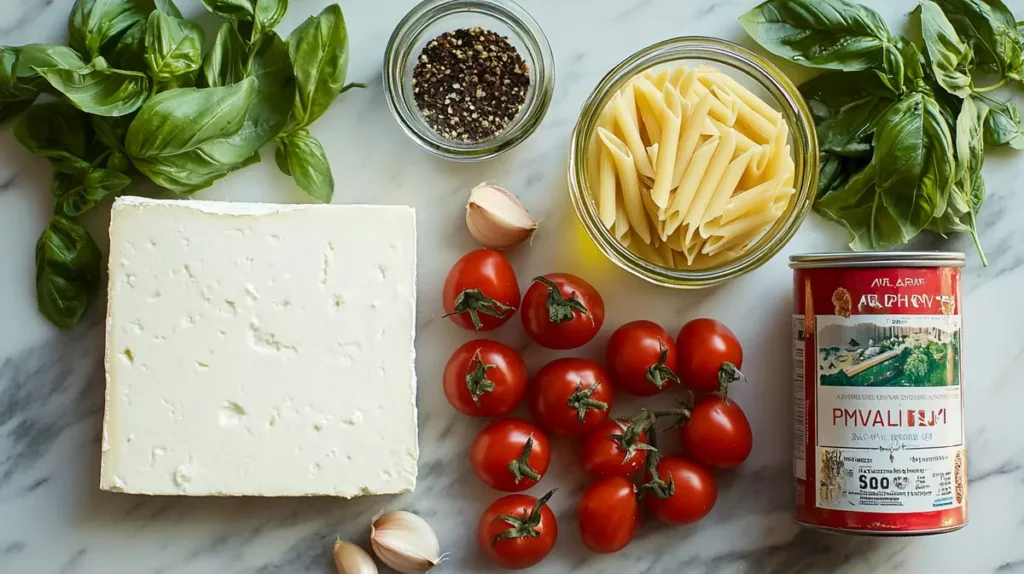
Additional Flavor Enhancers
- Red pepper flakes – For heat and balance
- Fresh basil or oregano – Brightens the dish with herbal notes
- Salt and pepper – Keep it minimal—feta is already salty
- Lemon zest (optional) – Adds brightness to cut the richness
These ingredients roast together in one dish, creating a luscious, creamy sauce once stirred into hot pasta. The simplicity is part of what makes baked feta pasta such a reliable go-to.
Step-by-Step Recipe for the Perfect Baked Feta Pasta
Making baked feta pasta is as easy as roasting, stirring, and serving. You don’t need to fuss over saucepans or timers. Just follow these steps to create a restaurant-worthy dish with barely any cleanup.
How to Roast the Feta and Tomatoes
What You’ll Need:
- 1 block (about 7–8 oz) feta cheese
- 2 pints cherry or grape tomatoes
- 3–4 cloves garlic, peeled
- ¼ cup extra virgin olive oil
- ½ tsp red pepper flakes (optional)
- Salt and black pepper, to taste
- Fresh basil or oregano (for garnish)
Instructions:
- Preheat your oven to 400°F (200°C).
- In a medium baking dish, add the cherry tomatoes, garlic, olive oil, salt, and pepper. Toss gently to coat.
- Place the block of feta in the center of the dish, nestled between the tomatoes. Drizzle a bit more olive oil over the cheese.
- Sprinkle red pepper flakes over everything for a spicy kick, if desired.
- Bake uncovered for 30–35 minutes, or until the tomatoes are blistered and the feta is golden and soft.
The dish should be bubbling, aromatic, and ready to transform into sauce.
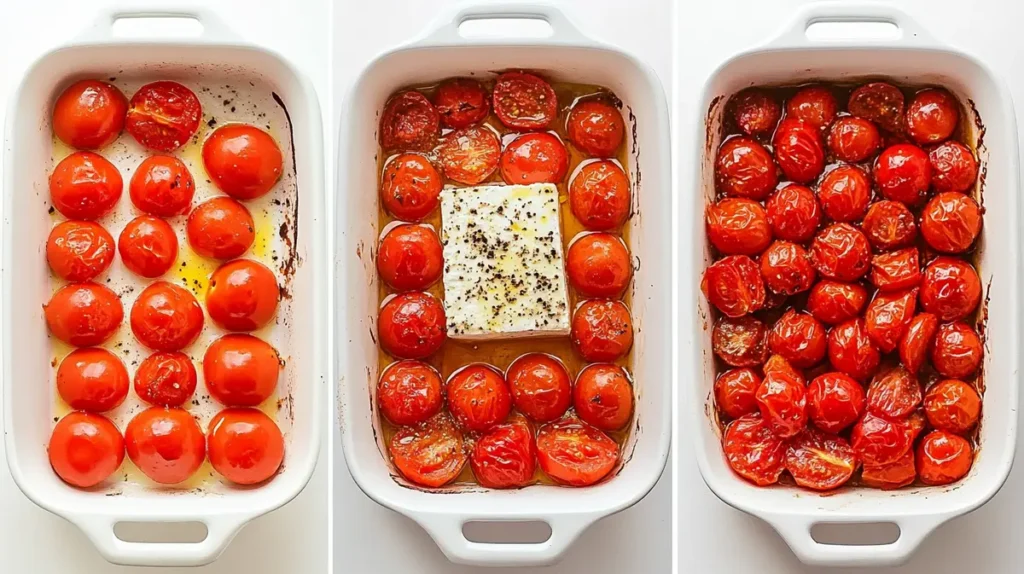
Combining with Pasta and Seasonings
While the feta and tomatoes are roasting, cook your pasta.
Pasta Prep:
- Boil 10–12 oz of pasta (penne, rigatoni, or rotini work well).
- Salt your water generously.
- Cook until al dente, then reserve ½ cup of pasta water before draining.
Final Assembly:
- Remove the baking dish from the oven.
- Use a fork or spoon to mash the feta and tomatoes together until creamy and well combined.
- Add the hot pasta to the dish and stir gently.
- If needed, add a splash of reserved pasta water to loosen the sauce.
- Taste and adjust seasoning—add fresh basil or a little lemon zest for brightness.
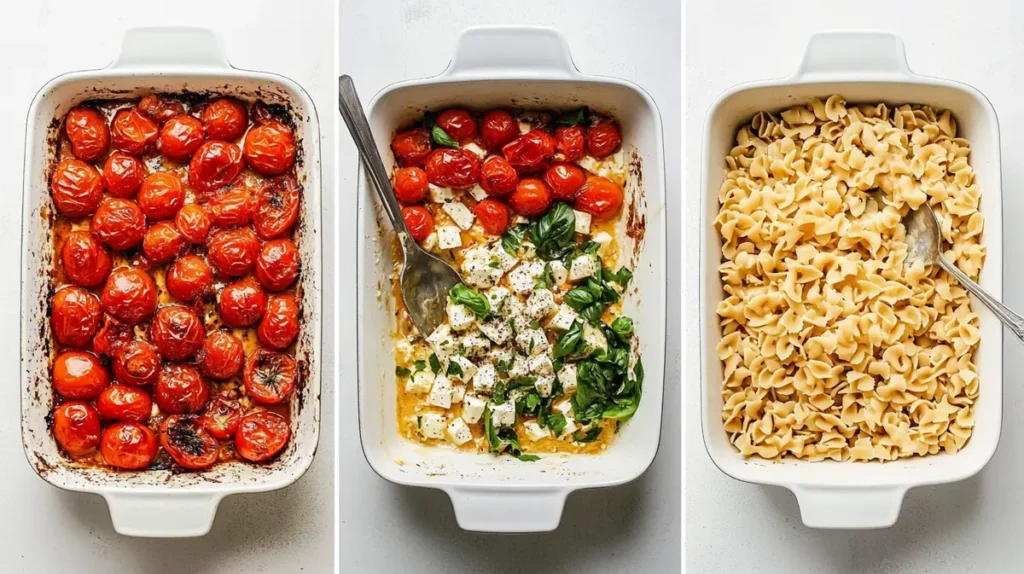
That’s it! You now have a velvety, flavor-packed baked feta pasta ready to serve.
Looking for a sweet finish? Try this creamy vegan chocolate oatmeal as a dessert after this tangy, savory main.
Best Pasta Shapes to Use for Baked Feta Pasta
The pasta you choose can make or break your baked feta pasta experience. Since the sauce is creamy and chunky—with bits of roasted tomato, garlic, and soft feta—you want a shape that grips and holds all that flavor in every bite.
Pasta Types That Hold Sauce Well
For maximum creaminess and perfect forkfuls, go for pasta shapes with ridges, curves, or hollow centers. These hold the sauce better and give more texture contrast.
Top Pasta Picks:
- Rotini – Its spiral shape captures sauce and tomato chunks beautifully.
- Penne – The hollow center and slanted edges scoop up creamy bits with ease.
- Rigatoni – A hearty tube pasta with deep ridges—ideal for baked feta sauce.
- Fusilli – Similar to rotini, it’s great for getting sauce in every twist.
- Orecchiette – The little “ears” cradle melted cheese and roasted tomatoes nicely.
Tip: Avoid thin noodles like spaghetti or linguine. They don’t hold the creamy sauce as well and may leave the dish feeling flat.
Gluten-Free and Whole Grain Options
If you’re gluten-sensitive or simply prefer more fiber, there are plenty of pasta alternatives that work well in baked feta pasta without sacrificing texture.
Gluten-Free Options:
- Chickpea or lentil pasta – High in protein and slightly nutty in flavor
- Brown rice pasta – Neutral and firm enough to hold sauce
- Quinoa pasta – Earthy flavor and good structure
Whole Grain Options:
- Whole wheat penne or rotini – Adds a hearty, nutty undertone that pairs well with salty feta and sweet tomatoes
Choose your pasta based on what you enjoy, but remember: the goal is to catch the sauce, not lose it to the bottom of the bowl.
Flavor Variations and Add-In Ideas
The beauty of baked feta pasta is that it’s incredibly versatile. Once you’ve mastered the core method, you can switch up the ingredients to match your mood, the season, or whatever’s in your fridge. Whether you want more veggies, extra spice, or a protein boost, there are endless ways to personalize this viral dish.
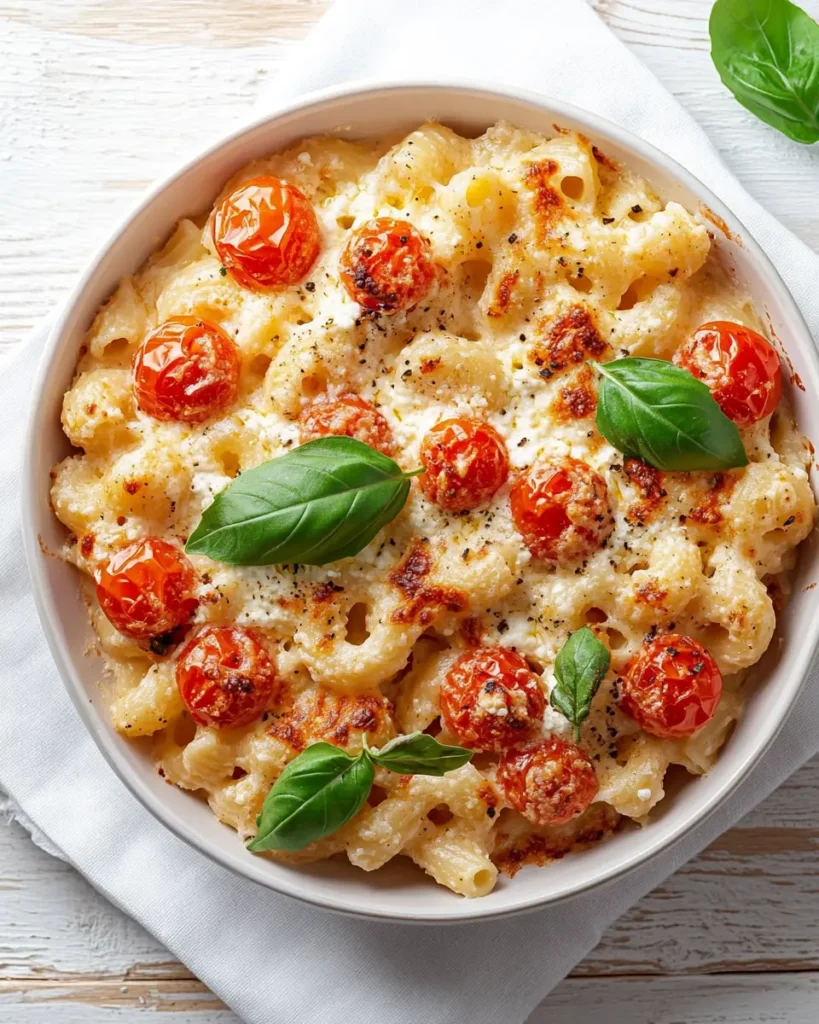
Roasted Veggies, Spinach, or Protein
Adding vegetables or plant-based protein transforms this side-worthy pasta into a complete, nourishing meal.
Add-In Ideas:
- Spinach or kale – Stir in fresh greens right after mixing the pasta for wilted texture and added nutrients
- Roasted zucchini or eggplant – Slice thin and roast alongside the feta and tomatoes
- Artichoke hearts – Add after roasting for a Mediterranean twist
- Mushrooms – Sauté separately and stir in for extra umami
- Tofu or chickpeas – For a vegan protein boost, toss in crispy chickpeas or roasted tofu cubes
These mix-ins add body and balance, turning your baked feta pasta into a full-fledged main dish.
Spice It Up: Red Pepper, Lemon Zest, Herbs
Looking to bring even more boldness to the sauce? A few small tweaks make a big difference in flavor.
Flavor Boosters:
- Red pepper flakes – For heat that balances feta’s richness
- Lemon zest or juice – Adds brightness and cuts through the creaminess
- Fresh basil or thyme – Stir in fresh herbs at the end for a fragrant finish
- Capers or olives – For a salty, briny edge that deepens the flavor profile
- Sun-dried tomatoes – Mix in for added sweetness and chew
Want to really impress dinner guests? Finish with a drizzle of high-quality chili oil or infused olive oil to add a chef-level touch to your baked feta pasta.
Make It Vegan or Dairy-Free Without Losing Creaminess
The original baked feta pasta may rely on dairy cheese, but there’s no reason you can’t enjoy a fully plant-based version. With today’s vegan products—and a few clever swaps—you can recreate the tangy, creamy magic of the original recipe without any animal ingredients.
Best Vegan Feta Alternatives
To make this recipe dairy-free, the most important swap is the feta cheese. Luckily, there are several vegan versions available that work beautifully when baked.
Recommended Vegan Feta Brands:
- Violife Just Like Feta – Mild, creamy, and bakes well
- Follow Your Heart Feta Crumbles – Slightly crumbly, great tang, and melts slightly
- Trader Joe’s Vegan Feta Cheese Alternative – A solid option with excellent flavor and texture
Choose a block-style vegan feta for the best melt and presentation in your baked feta pasta.
Plant-Based Additions for Creamy Texture
If you can’t find store-bought vegan feta, or want a more whole-food approach, try these:
DIY Creamy Base Options:
- Cashew ricotta – Soak and blend cashews with lemon juice, garlic, and nutritional yeast
- Tofu feta – Marinate extra-firm tofu in lemon juice, apple cider vinegar, and miso for flavor
- Blended white beans – Use cannellini beans blended with garlic and olive oil for a creamy, protein-rich base
Stir these options in after roasting the tomatoes or bake them directly with the veggies to mimic the original texture of baked feta pasta.
Keep the Flavor, Lose the Dairy
To retain the bold flavor of traditional feta, use acidic and savory ingredients that give your vegan version balance:
- Lemon juice or zest – Brightens the sauce
- Nutritional yeast – Adds a cheesy, umami-rich flavor
- Miso paste – Just a small amount deepens the flavor profile
- Fresh herbs – Basil, oregano, and thyme all enhance plant-based alternatives
With the right swaps, you’ll still enjoy a creamy, tangy, and comforting bowl of baked feta pasta—now completely dairy-free and vegan-friendly.
Storage, Reheating, and Leftover Tips
One of the best parts of baked feta pasta is how well it holds up for leftovers—if you’re lucky enough to have any! With just a few smart storage and reheating tips, you can enjoy that creamy, tangy texture again the next day without it turning dry or mushy.
How to Store Baked Feta Pasta
Once cooled to room temperature, transfer your leftover baked feta pasta to an airtight container.
- Store in the refrigerator for up to 4 days
- Keep it separate from any fresh herbs you plan to add (store those in a sandwich bag or wrap in paper towel)
- If the pasta looks dry after refrigeration, don’t worry—you can bring it back to life with a little liquid during reheating
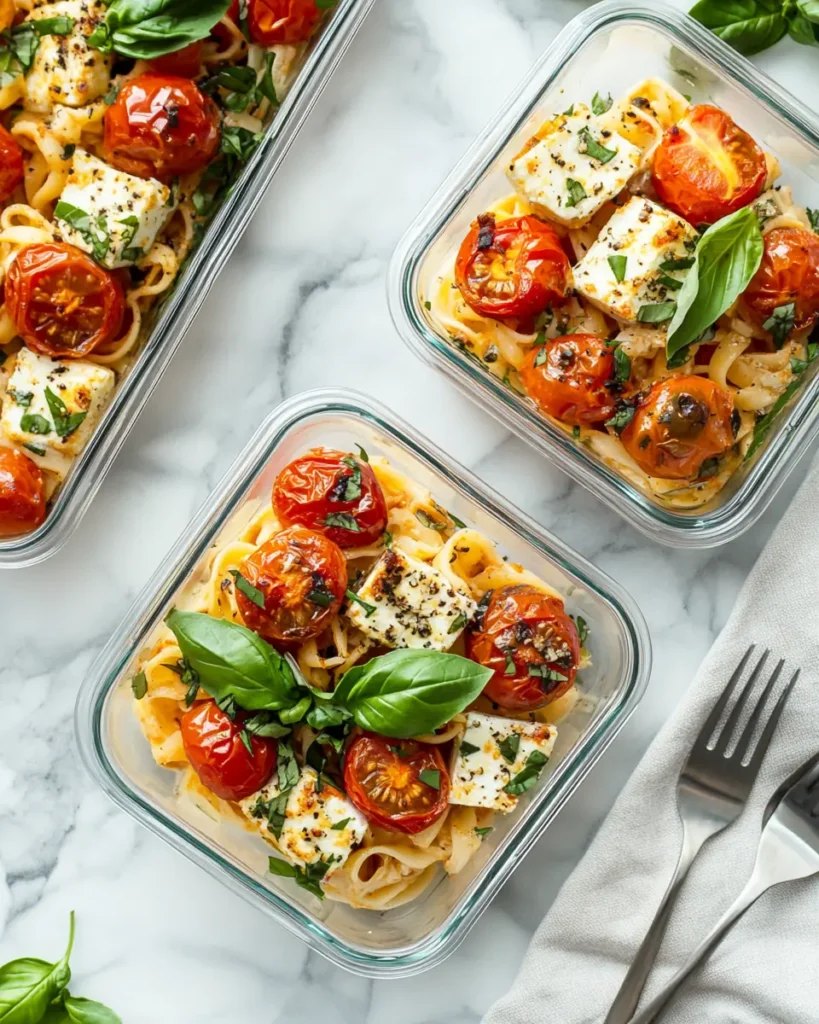
Best Reheating Methods for Creamy Texture
Because the feta-based sauce thickens as it chills, the key to reheating is to loosen it gently while preserving flavor.
Stovetop Reheating (Recommended):
- Add the pasta to a nonstick skillet with a splash of plant milk, water, or olive oil
- Warm over low to medium heat, stirring frequently until heated through
- Add a pinch of red pepper or a squeeze of lemon juice to refresh the flavor
Microwave Option:
- Transfer pasta to a microwave-safe bowl
- Add 1–2 tablespoons of liquid (plant milk, broth, or water)
- Cover with a lid or damp paper towel
- Microwave in 30-second bursts, stirring in between until hot
Want to make it feel brand new? Top with fresh basil, a sprinkle of nutritional yeast, or even toss in some leftover roasted veggies before reheating.
Can You Freeze Baked Feta Pasta?
Technically yes, but it’s not ideal. Freezing will dull the flavor of the tomatoes and may affect the creamy consistency of the sauce. If you must freeze:
- Use airtight, freezer-safe containers
- Reheat on the stovetop with additional liquid
- Avoid freezing pasta that’s already overcooked—it may turn mushy when thawed
Looking for more meal-prep–friendly dishes? Check out our Hearty Vegan Minestrone Soup—a freezer-friendly favorite that pairs perfectly with pasta nights.
Nutritional Profile and Health Considerations
Baked feta pasta may taste indulgent, but it can be surprisingly balanced—especially when made with high-quality ingredients and smart add-ins. Whether you’re watching sodium, counting calories, or just trying to eat more whole foods, this recipe can be adapted to fit your goals.
Calories, Protein, and Fiber
A standard serving of baked feta pasta (with pasta, cheese, and tomatoes) delivers:
| Nutrient | Per Serving (Approx.) |
|---|---|
| Calories | 400–500 kcal |
| Protein | 12–15g |
| Fat | 20–25g |
| Carbohydrates | 40–50g |
| Fiber | 4–7g (varies by pasta) |
Much of the fat comes from feta and olive oil, which are rich in monounsaturated fats—beneficial for heart health in moderation.
For added fiber and protein, consider:
- Whole wheat or legume-based pasta
- Chickpeas or lentils stirred in after baking
- Greens like spinach or kale for volume and nutrients
Using lentil or quinoa pasta turns your baked feta pasta into a higher-protein, gluten-free meal that stays satisfying for hours.
How to Lighten It Up Without Losing Flavor
If you’re trying to reduce calories or sodium, a few easy swaps will make a big difference:
Lightening Tips:
- Use low-fat or reduced-sodium feta to cut back on salt and saturated fat
- Reduce olive oil from ¼ cup to 2 tablespoons and roast with parchment to prevent sticking
- Add more non-starchy vegetables (zucchini, mushrooms, spinach) to increase volume without added calories
- Mix in a little lemon juice or zest to brighten the flavor so you can use less cheese
With these tweaks, you can enjoy the creamy, oven-roasted flavor of baked feta pasta any night of the week—guilt-free and fully satisfying.
Common Mistakes to Avoid with Baked Feta Pasta
While baked feta pasta is famous for being easy and foolproof, there are a few key mistakes that can turn your creamy dream into a bland or clumpy disappointment. Avoid these common errors to get the best flavor and texture every time.
Using Crumbled Feta
Pre-crumbled feta doesn’t bake or melt properly. It often contains anti-caking agents that prevent it from getting that soft, creamy texture.
Fix:
Always use a block of feta cheese—preferably in brine. It holds its shape while baking and melts beautifully when stirred.
Overbaking the Feta
Feta is delicate. If you leave it in the oven too long, it can become dry and rubbery instead of soft and spreadable.
Fix:
Bake at 400°F (200°C) for 30–35 minutes—just enough time for the tomatoes to blister and the feta to soften without drying out.
Undercooked or Overcooked Pasta
Overcooked pasta becomes mushy when mixed with the hot sauce, while undercooked pasta doesn’t hold the flavor well.
Fix:
Cook pasta until al dente, and reserve a bit of pasta water to adjust sauce consistency if needed.
Not Seasoning the Tomatoes
Roasting tomatoes without salt, garlic, or oil results in a watery, underwhelming sauce.
Fix:
Toss your tomatoes with olive oil, salt, pepper, and garlic before baking to develop depth and prevent them from drying out.
Stirring Too Late or Too Soon
Timing matters when combining the sauce and pasta. Wait too long, and the feta starts to solidify. Stir too early, and the sauce doesn’t meld properly.
Fix:
Mix the pasta into the baking dish as soon as it’s out of the oven and the pasta is drained. Stir gently until creamy and well combined.
Avoiding these mistakes ensures your baked feta pasta is tangy, creamy, and packed with flavor every time—just like the viral version that started it all.
Frequently Asked Questions
Can I make baked feta pasta without cherry tomatoes?
Yes! You can use grape tomatoes, halved Roma tomatoes, or even canned whole tomatoes (drained). The key is roasting them until soft and blistered, so they create a juicy base for the feta sauce.
Is baked feta pasta healthy?
Baked feta pasta can be part of a balanced diet. Use whole grain pasta, reduce the olive oil slightly, and load up on vegetables to boost fiber and nutrition. Opt for reduced-fat feta if watching calories.
What type of feta works best?
Use a block of feta packed in brine. It melts better and has a richer flavor compared to pre-crumbled feta. Sheep’s milk feta is tangier, while cow’s milk feta is milder and creamier.
Can I make it vegan or dairy-free?
Absolutely. Use a vegan feta alternative like Violife or make your own using tofu or cashews. Pair with your favorite plant-based pasta and roasted veggies for a creamy vegan version.
What pasta shape is best for baked feta pasta?
Choose pasta that holds sauce well, like rotini, penne, rigatoni, or fusilli. Avoid thin pasta like spaghetti, which doesn’t grip the creamy sauce as effectively.
Can I use crumbled feta instead of a block?
Technically yes, but it won’t melt as well. Crumbled feta contains anti-caking agents that affect texture. A block of feta gives the best creamy results.
✅ Conclusion: Baked Feta Pasta Is Worth the Hype
Simple, bold, and always crowd-pleasing, baked feta pasta is one of those dishes that proves you don’t need a long list of ingredients to make something memorable. Whether you’re following the original version or experimenting with plant-based tweaks, it’s a creamy, tangy pasta that never fails to deliver.
With the right cheese, a handful of roasted tomatoes, and your favorite pasta, dinner practically makes itself.

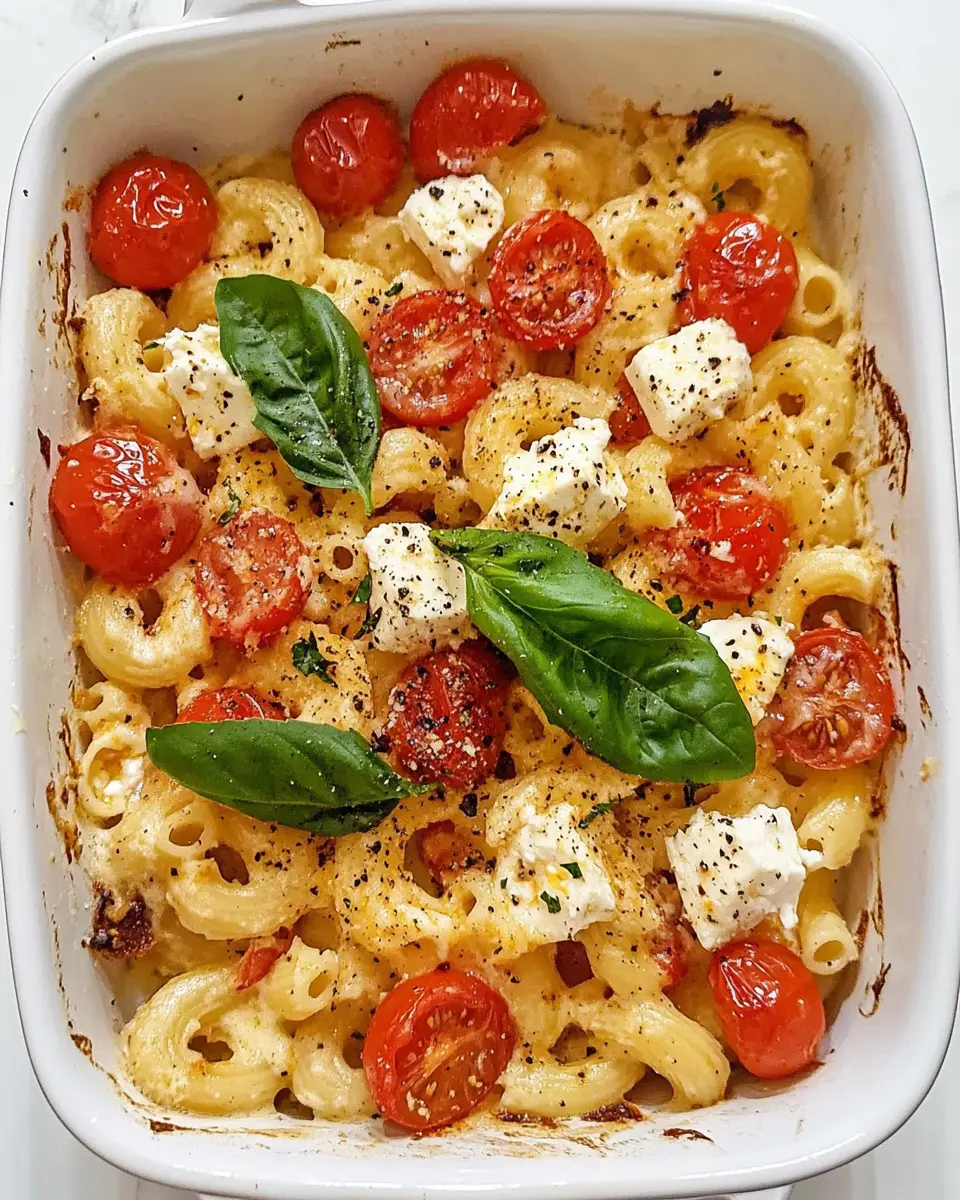
1 thought on “Baked Feta Pasta – Creamy, Tangy, and Oven-Roasted Perfection”